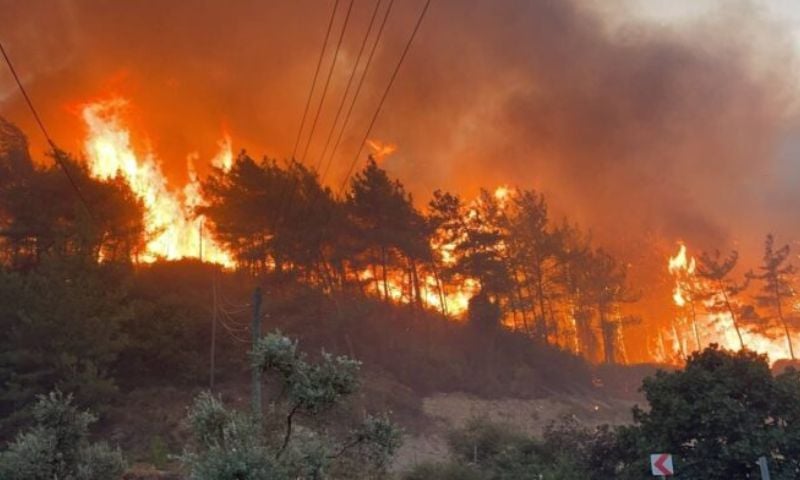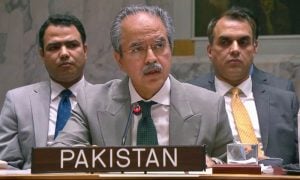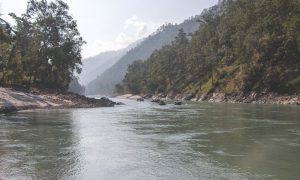PESHAWAR, Pakistan: The night of May 17, 2025, was not just lit by stars, but by the flames licking the sky.
A ferocious blaze swept through the rugged hills of Allahdand in Malakand district—87 kilometres north of Peshawar—casting an eerie, amber glow that was visible for miles around.
For 60-year-old Liaqat Ali, it was a night etched in memory like a burn mark. “The fire spread like a storm,” he recalls, his voice still carrying the disbelief of that night.
“We used buckets of water and wet cloths, but we couldn’t stop it. We lost all the grass for our animals and the wood we use every day for cooking and heat.”
His farmland lay scorched, reduced to ash and memory—a fate shared by countless others across Khyber Pakhtunkhwa (KP), from the icy heights of Upper Chitral to the sunbaked plains of Kohat.
Forest fires, once rare and largely seasonal, are now flaring with alarming frequency, growing both in scale and intensity.
From hills to ash
According to the Khyber Pakhtunkhwa Forestry, Environment and Wildlife Department, the province recorded over 464 forest fires in 2022 and 2025, ravaging more than 14,000 acres of forest and grazing land.
In 2022 alone, four people lost their lives—one in Abbottabad and three in Mansehra—marking a grim shift in what were once low-impact incidents.
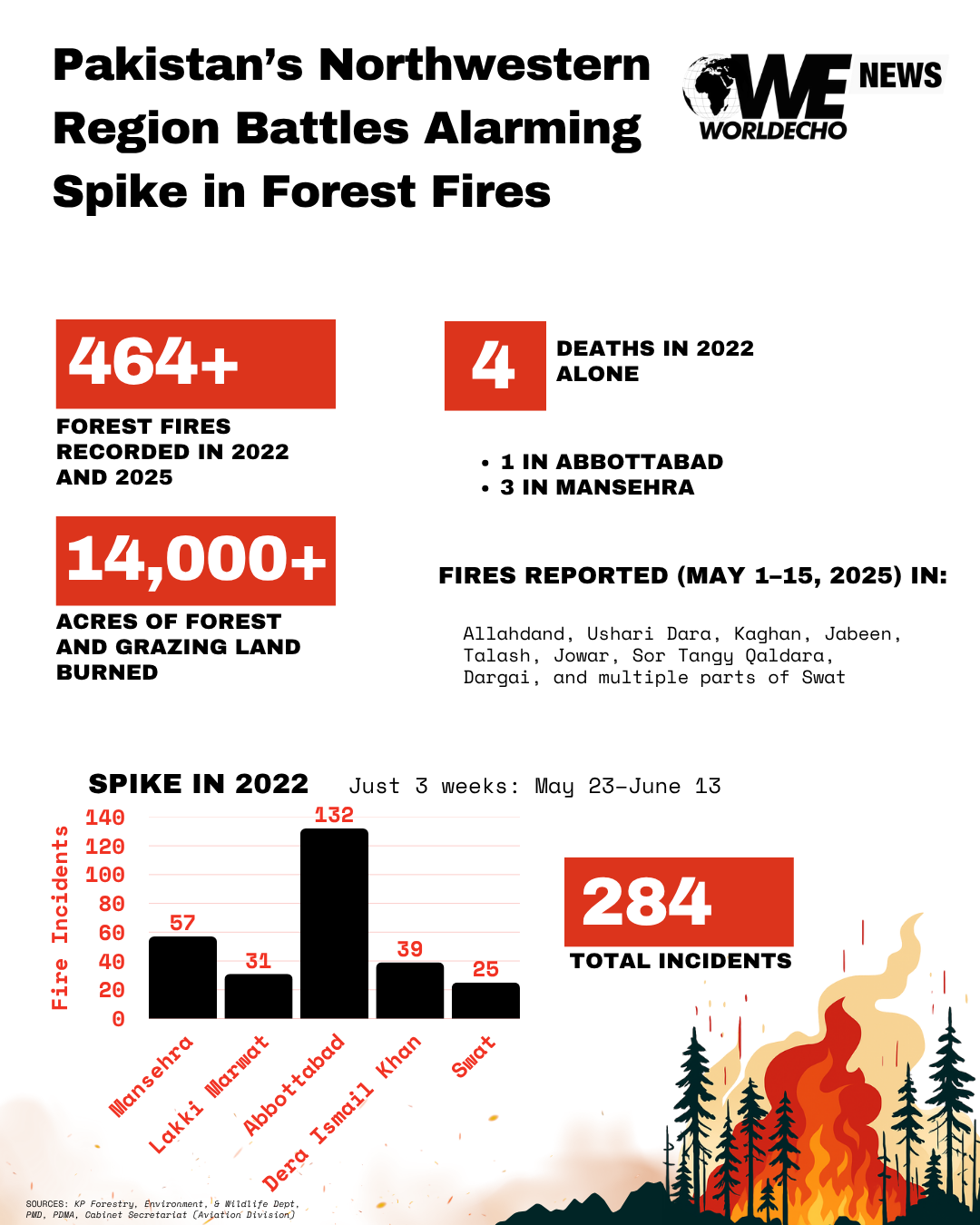
Nowhere is the crisis more evident than in the Malakand Division—comprising Swat, Shangla, Buner, Malakand, Upper and Lower Dir, Bajaur, and Upper and Lower Chitral districts.
In just the first 15 days of May 2025, wildfires erupted across the region—from Allahdand to Ushari Dara in Upper Dir to Kaghan, Jabeen, Talash in Lower Dir, Jowar in Buner to Sor Tangy Qaldara, Dargai, and stretched parts of Swat—turning lush green slopes into black scars.
We don’t have enough fire beaters, drones, protective gear, or water pumps. – a senior officer
While some fires—like the one in Allahdand—were eventually brought under control, forestry staff across Khyber Pakhtunkhwa remain on high alert due to relentless dry winds and parched earth that make even a spark a potential catastrophe.
Fire after fire
Back in 2022, a harrowing 284 fire incidents were recorded in just three weeks—from May 23 to June 13.
Abbottabad led the tally with 132 outbreaks, followed by Mansehra (57), Dera Ismail Khan (39), Lakki Marwat (31), and Swat (25).
But behind the cold arithmetic lies a much deeper ecological loss.
“The fires severely impact biodiversity and destabilise ecosystems,” says Dr. Muhammad Naeem, an ecologist at the Pakistan Forest Institute (PFI), nestled within the University of Peshawar campus.
The fires, he elaborates, destroy native trees, medicinal plants, and habitats of rare and endangered animals. “They wipe out the undergrowth and push wildlife out of their natural territories,” he says.
He explains that most of these were ground fires, burning dry grass, fallen leaves, and small bushes, often spreading quietly until they became uncontrollable.
Fuelled by climate
Adding urgency to the crisis is the changing climate. Dr. Rafiqullah, a climate scientist at the University of Peshawar’s Environmental Sciences Department, points to a dangerous new pattern: “We’re seeing earlier snowmelts, longer dry spells, and rising temperatures—factors that are turning our forests into tinderboxes.”
His warning aligns with multiple heatwave alerts issued by the Pakistan Meteorological Department and Provincial Disaster Management Authority (PDMA) in 2022.
On June 4, mountainous communities were advised to brace for extreme temperatures—a climate alarm many believe went unheeded.
A Cabinet Secretariat of the Aviation Division’s advisory dated April 27, 2022, predicted temperatures 5–7 degrees centigrade (°C) above normal in Gilgit-Baltistan and Khyber Pakhtunkhwa, raising alarms over potential glacial lake outburst floods (GLOFs).
Man-made infernos
While some wildfires are sparked by natural causes, many are human-induced—either accidentally or, disturbingly, on purpose.
Khyber Pakhtunkhwa Forestry Department Spokesman Latifur Rehman says that tourists often light fires carelessly.
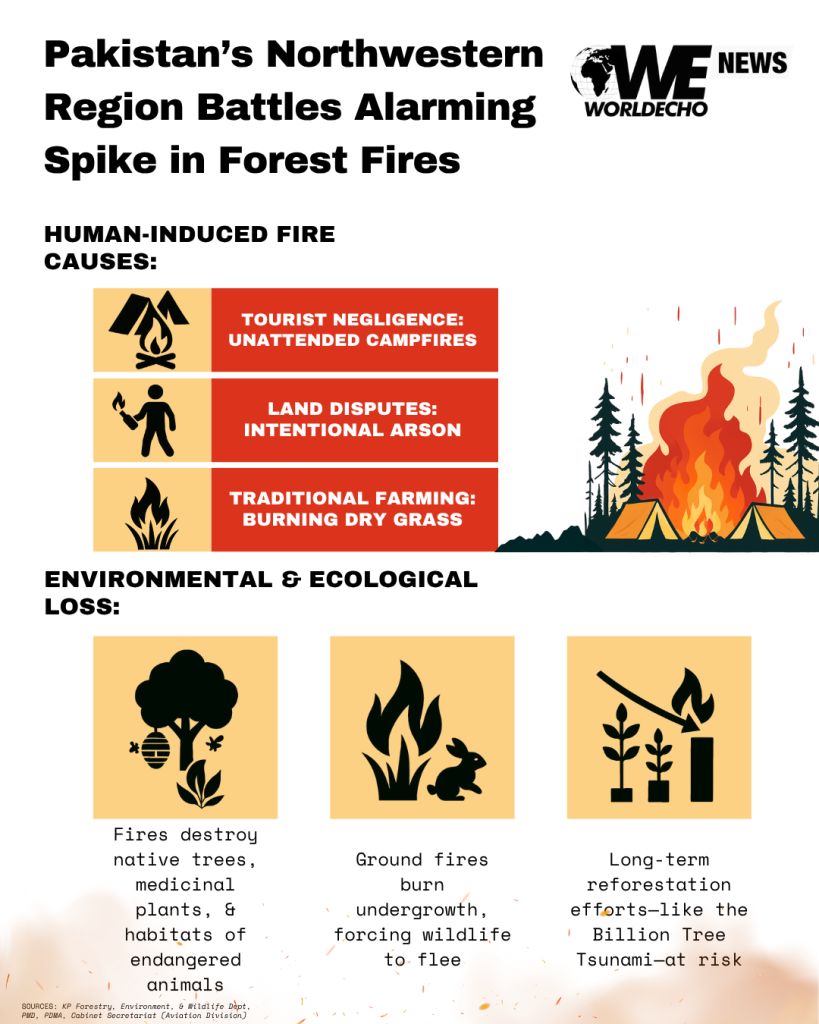
“This year, we launched an awareness campaign in March and April through social media, banners, pamphlets, and brochures [against lighting fires unnecessarily].”
He adds that traditional farming also plays a role. Farmers often burn dry grass to encourage new growth—a method that, if unchecked, can quickly turn into an uncontrollable blaze.
Even more alarming, in Shangla, several fires, reported in June 2022, were allegedly ignited as part of land disputes, according to local media.
Battling with bare hands
When flames erupt, the first to respond are often Rescue 1122 teams, forest guards and community volunteers. But response capacity remains woefully inadequate in the face of growing emergencies.
The future of Khyber Pakhtunkhwa’s forests doesn’t rest only in planting trees. It lies in smart management, community engagement, and year-round planning – Dr. Rafiqullah.
A senior officer in the Malakand Forest Division, who wishes not to be named, paints a stark picture of the challenges on the ground.
“We don’t have enough fire beaters, drones, protective gear, or water pumps. The terrain adds another layer of difficulty.”
Each forest guard in Khyber Pakhtunkhwa is responsible for 4,000 to 5,000 hectares—a workload that far exceeds the global standard of 500-1,000 hectares in mountainous regions.
With just 3,500 guards tasked with safeguarding 1.5 million hectares of forest, the odds are stacked against them.
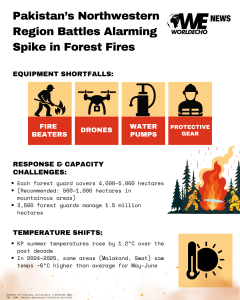
Trees in the crosshairs
While Khyber Pakhtunkhwa earned international recognition for its Billion Tree Tsunami initiative—launched under a previous PTI government in Khyber Pakhtunkhwa—but experts now fear that forest fires are quietly eroding those hard-won gains.
“Reforestation is a long-term investment,” says Dr. Ayesha Khan, a forest governance expert at the University of Agriculture, Peshawar. “But without proper protection and management, we risk losing it all during one fire season.”
The concern is echoed by Latifur Rehman. “We’ve planted millions of trees. Now the real challenge is protecting them, for which we have taken several steps on the division level.”
Call for action
Dr. Naeem and other experts are now calling for a comprehensive forest fire prevention strategy. Their recommendations include the use of satellite technology and weather tracking to monitor fire risk.
Dr Naeem suggests training local communities in firefighting and early response. He also advocates for a ban on open fires and camping in high-risk areas during dry months, as well as the regular creation of firebreaks and clearing of dry vegetation to reduce fuel for wildfires.
Peer Mosavir Khan, Special Advisor to the Chief Minister on Forests, emphasises public responsibility.
“Please don’t light fires or cook in forest areas. Tourists must extinguish their campfires completely. One careless act can destroy entire ecosystems,” he warns.
In a recent social media appeal, Khan urged tourists and citizens to avoid open flames near forests and to treat nature with care and respect.
The Forestry Department has also asked the public to report fire incidents immediately, follow all safety protocols, and seek permission before burning anything, even on private property.
A hotter future
Data from the Pakistan Meteorological Department shows that average summer temperatures in Khyber Pakhtunkhwa have risen by 1.2°C over the past decade.
In 2024 and 2025, parts of Malakand and Swat recorded temperatures exceeding 6°C, higher than the region’s average for May and June.
For experts like Dr. Rafiqullah, the message is clear. “The future of Khyber Pakhtunkhwa’s forests—and the people and wildlife who depend on them—doesn’t rest only in planting trees. It lies in smart management, community engagement, and year-round planning.”
Without that, today’s infernos may just be the tip of the iceberg.









